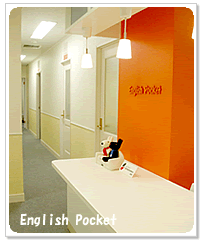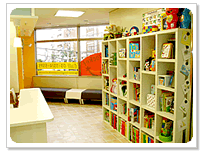 |
 |
| Pocket International Preschool |
| ‘Kamikitazawa School |
@3-33-12 Kamikitazawa
@Setagaya Tokyo
@Zip: 156-0057
@Tel: 03-5317-4002
@e-mail: info@englishpocket.com |
| ‘Koenji School |
@4-7-3-2F Koenji Minami
@Suginami Tokyo
@Zip: 166-0003
@Tel: 03-3314-5595
@e-mail: koenji@englishpocket.com |
| ‘Ogikubo School |
@1-18-16-3F Kamiogi
@Suginami, Tokyo
@Zip: 167-0043
@Tel: 03-3220-8223
@e-mail: ogikubo@englishpocket.com |
|
|
| We have taken great care in designing our curriculum which is modeled upon
the curriculum used in the state of California. This curriculum is particularly
sensitive to the ESL requirements of our students and takes this into account
by employing the repetition of specific phrases throughout various projects
and activities the students are involved with. |
| For example, Instead of saying three phrases for the same thing, we focus
on one phrase. In an ESL environment this is particularly important to
developing a strong foundation in English. If students can focus on a particular
phrase such as "Put it on the table.", later, they will be able
to quickly learn other related phrase like "Set in on the table."
and "Place it on the table." It's also important to note that
this curriculum doesn't only focus on English education. Instead we try
to strike a good balance in developing a child's emotional, physical, social
and academic well-being along with math, science, art and music. In all
of these activities, we encourage our students not just to listen but to
do and make. |

| Pre 1 - 1st Year Preschool < For 1.5 - 2 years old > |
| At this age, the students are introduced to range of new experiences and will explore their new found independence. The students will be introduced to the basics of the English language, basic classroom routines, and learning to take care of personal items. |
| Traditional |
Days of the Week |
| Manuscript |
Months, Counting, Weather, Seasons |
| Numbers |
1 - 10 |
| Movement |
Singing and Dancing |
| Shapes |
Circle, Square, Triangle |
| Colors |
Yellow, Orange, Red, Pink, Blue, Green, Purple, Black, White |
| Alphabet |
Upper Case Letters |
| Lower Case Letters |
| Art and Craft |
Fine Motor Skills, Using Glue, Exposure to a Range of
Different Textures, Painting
|
|

| Pre 2 -2nd Year Preschool For 2`3 years old |
| At this age, children are learning to become independent from their mothers and are learning about self-awareness. It is here where the educational adventure begins. |
| Traditional |
Days Of The Week |
| Manuscript |
Months, Seasons & Special Days |
| Alphabet |
Lower Case Letters |
| Phonics Sounds |
Vowels, Consonants |
| Numbers |
1 to 20 |
| Colors |
Black, Blue, Brown, Green, Orange, Pink, Purple, Red, White, Yellow |
| Shapes |
Recognizing Shapes |
| Circle, Triangle, Rectangle, Heart, Square, Diamond, Oval |
| Social Study Context |
Grouping, Patterns, Matching, Practicing Odd |
|

| K1 - 1st Year Kindergarten For 3`4 years old |
| At this age, children begin to enjoy stronger relationships with others and learn about participating in a group. As they gradually recognize the differences between themselves and others, it is our goal to teach them the rules governing social interaction. Creative activities play a big role in accomplishing this and also help students start to use and develop their imaginations. |
| Traditional |
Days Of The Week |
| Manuscript |
Months, Seasons & Special Days |
| Penmanship |
Upper Case Letters |
| Lower Case Letters |
| Phonics |
Vowels, Consonants |
| Reading |
CVC words |
| Sight words |
| Key Sentences |
| Decodable Books |
| Reading Basket |
Writing
|
All letteres of alphabet |
| Full name |
| CVC words sentences |
| Math Concept |
Problem solving, Measurements, Number writing/ recognizing counting, Greater than/Less than |
| Numbers |
1 to 50 |
| Colors |
Mixed Colors |
| Language Art |
Same and Opposites |
| First, Next, Last |
| Reading Words, High- Frequency Words, Rhyming Words, Compound Words, |
| Sequencing A Story, Reading Sentences |
|

|
K2 - 1st Year Kindergarten For 4`5 years old
|
| During the students second year in our kindergarten program, the
students will be well aware of who they are and will become more aware
of others feelings. They will have a deep understanding of right and
wrong and will understand what is expected of them in the classroom.
They will know the routines of the school and become more aware of
time. They will be able to express their feelings well and will have a
clear understanding of what they like and dislike. This year is a very
important year as they start to express their feelings through their
writing.
|
| Traditional |
Days Of The Week |
| Manuscript |
Months, Seasons & Special Events |
| Phonics |
Consonant Blends - Start / End, Digraphs, |
| Long Vowels, Silent Letters |
| Reading |
Sight words, Decodable Books, Main Characters, Storylines, |
| Introduction to basics of a sentence, Capitalizing, periods, Question marks |
| Language Arts |
Capitalizing first letter, Proper nouns, Puntuation |
| Writing | Complete Setences, Short Letters & Stories, Cards, Creative Writing |
Math
|
| Counting 1 - 50, Writing Double Digits, Grouping and Sorting |
| Addition and Subtraction, Fractions |
| Art & Craft |
Painting, Using Scissors, Expressing Emotions through Art, Sculpting |
|

| K3-3rd Year KindergartenFor 5`6years old |
| By the time children reach this age, they have made substantial cognitive
and physical progress, and their interaction with others has become quite
complex. The games they are capable of are also quite complex, requiring
speed and rhythm. At this stage of development, children develop an ability
to compare and contrast their behavior with that of others. Part of this
behavior awareness includes developing an understanding of right and wrong.
During this time, it is critical that children be immersed in a good educational
environment. With these things in mind, we aim to provide a high level
of academically focused education while simultaneously nurturing the students'
self-esteem, while promoting good behavior and confidence. |
| Traditional |
Days Of The Week |
| Manuscript |
Months, Seasons & Special Days |
| Reading |
Finding The Main Idea, Reading For Details |
| Visualizing, Identifying Cause & Effect, Fact & Opinion |
| Capitalizing First Word & I, Recognizing Periods, Chapter Books |
| Phonics |
Leveled Books |
| Double Vowels |
| Murmuring Vowels |
| Y sounds |
| Grammar |
Compound Words |
| Subject/Predicate |
| Verbs |
| Nouns |
| Adjectives |
| Pronouns |
| Adverbs |
| Writing Practice |
Completing A Sentence |
| Writing 3-Part Sentences, Adding Adjectives |
| Writing Sentences & Questions |
| Sentence Combining, Sentence Building, Creative Writing |
| Map Skills |
Map Words, Directions, Symbols, Land & Water |
| Neighborhood (Map), World Map |
| Math |
Problem Solving |
| Greater than/Less than |
| Addition |
| Subtraction |
| Counting by groups |
| Couting to 100 and more |
| Measurement |
| Science Context |
Sink or Float, Plants |
| Materials (Solids, Liquids, Gases) |
| Art & Craft |
Using Scissors,Painting, Sculpting, Creative drawing, book illustration |
|

| General Information About Our Academics |
| Phonics Education |
| Most importantly in our academics, phonics comes first. It is essential
to a successful English education. Through phonics children not only become
familiar with the building block sounds of the English language, but phonics
opens up a world of reading and writing, both of which are critical to
learning new vocabulary and grammar. From our youngest class to our oldest
class, phonics is fully integrated into the program. In our customized
graduated curriculum, children are introduced to beginning and then middle
and ending consonants, short vowels, long vowels, and then diagraphs, r-controlled
vowels, and finally vowel combinations and dipthongs. By the time our students
finish this program, they have excellent reading and writing abilities.
Finally, it is an educational imperative here that students not only learn
how to read but how to understand what they read. With this in mind, all
of our reading actvities occur as an ongoing dialogue between the teacher
and students where they discuss the meaning of the content. Often, at advanced
levels, our students write short passages summarizes a particular story
or simply telling a story which they imagined. |
| PIP Sight Words and Reading |
| In PIP we make sure our students learn at least the first 200 of
Fry's Instant sight words. Fry's instant sight words are a list of the
words that appear most frequently in books. By learning these words students
begin to focus on what they are reading instead of trying to figure out
every word. We believe that the goal of the learner should not only be
to be able to read the text but also to understand and respond to what
they are learning. |
| Science |
| PIP science is all about exploring and asking questions. During class
time we do challenging and fun experiments that allow the students to understand
their world. Topics include, plants, animals, weather and water. Each experiment
follows the scientific method which all students understand. The scientific
method consists of a Question, Hypothesis (guess) Test, and Conclusion.
Students enjoy whether or not their hypothesis is correct. Two examples
of questions are: How can you move a magnet without touching it? What will
happen to water left in the sun? A student who is now in first grade put
it best when he wrote us a note saying "I love science. Your experiments
made me excited! Your science projects were so much fun!" |
|